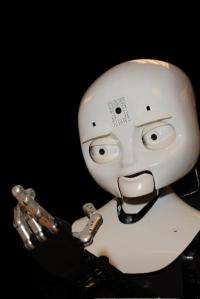NRL artificial intelligence team win 2 video awards (w/ Video)

Researchers at NRL's Navy Center for Applied Research in Artificial Intelligence, within the laboratory's Information Technology Division (ITD), received two top awards at the 21st International Joint Conference on Artificial Intelligence (IJCAI) held in California. Selecting from a cadre of 39 competitor videos, IJCAI awarded the NRL films with top honors in the categories of "Best Overall" and "Most Informative."
Since 2006, the Artificial Intelligence research community has held this prestigiously honored competition for videos documenting exciting artificial intelligence advances in research, education and application and that are accessible to a broad on-line audience.
"We are very excited to have won not just one, but two awards in our first year entering this competition," said Dr. Greg Trafton, section head, NRL Intelligent Systems Section. "Both videos are extremely entertaining and display the top-notch research currently occurring in artificial intelligence and robotics at NRL".
In the category of "Best Overall," the award went to "Casey's Quest: Transfer Learning for Adversarial Environments" by Kalyan Gupta, Matthew Molineaux and Philip Moore. The video describes recent research that ITD has conducted with members of Knexus Research Corporation and the University of Central Florida on the topic of transfer learning—the ability to leverage experience gained from one task to improve performance on a different task. In transfer learning, the software first learns the intent of an adversary in a multi-agent simulation game. It then uses this experience to assist in controlling friendly agents, and was shown to significantly increase scores for this task in comparison to the non-transfer agent, which was not provided with this experience. This has practicable application to the Navy by providing more realistic training scenarios for a variety of mission tasks and creating a more intelligent adversary in training simulators involving semi-automated forces.
In the category of "Most Informative," the award went to "Robotic Secrets Revealed, Episode 001" by Anthony Harrison, Ben Fransen, Magdalena Bugajska and Greg Trafton. This video highlighted recent gesture recognition work and NRL's novel cognitive architecture, ACT-R/E. While set in a popular game of skill, this video illustrates several Navy relevant issues, including: computational cognitive architecture that allows autonomous function and integrates perceptual information with higher level cognitive reasoning; gesture recognition for shoulder-to-shoulder human-robot interaction; and anticipation and learning on a robotic system. Such abilities will be critical for future Naval Autonomous systems for persistent surveillance, tactical mobile robots and other autonomous platforms.
NCARAI is engaged in research and development efforts designed to address the application of artificial intelligence technology and techniques to critical Navy and national problems. Research is directed toward understanding the design and operation of systems capable of improving performance based on experience; efficient and effective interaction with other systems and with humans; sensor-based control of autonomous activity; and the integration of varieties of reasoning as necessary to support complex decision-making.
Both award winning videos may found via the Internet by entering either of the below links.
Casey's Quest: http://videolectures.net/ijcai09_moore_cqtlfae/
Robotic Secrets Revealed: http://www.nrl.navy.mil/aic/iss/aas/CognitiveRobotsVideos.php
Source: Naval Research Laboratory (news : web)



















